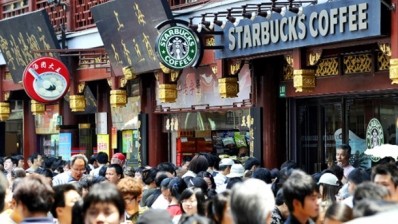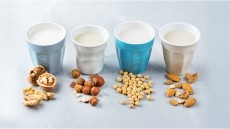China wakes up to instant coffee
up to 2003, international companies are queuing up to carve up
their slice of a market. Although tea is still the mainstay, the
rapid switch to all things western means that coffee looks set to
rival the national drink in next to no time.
According to the latest report from intelligence provider Euromonitor, total volume sales of coffee in China grew by nearly 90 per cent between 1998 and 2003, to 6,504.5 tonnes. Domestic production of coffee beans also expanded rapidly. China Agriculture Statistics show that China produced a modest figure of 3,573 tonnes of coffee beans in 1997, but by 2001 this figure was estimated to be13,000 tonnes.
In turn, local production of coffee beans coupled with the low price of green coffee in international markets has contributed to the reduction of the retail price of coffee in China. This situation encouraged investment in coffee, which in turn resulted in a higher visibility in the retail market, particularly in large cities. The level of publicity and media interest in coffee also notably increased.
Coffee is a Western concept to most Chinese consumers, who associate it with Western lifestyles. Unsurprisingly, coffee consumption in China is highly concentrated in large cities such as Beijing, Shanghai and Guangzhou. Coffee appeals to adventurous, open-minded, young, affluent, urban consumers, the report says. These consumers are more exposed to Western influences and tend to look up to Western lifestyles. Manufacturers have targeted Westernised young professionals as the main target market for coffee. The key issue is how to convince these consumers that coffee is a beverage to be drunk regularly rather than just a passing fad.
Another large consumer group, which influences the coffee consumption, is returnees. China has seen an influx of returnees (mainland Chinese students returning from Western countries) over the last five years. Euromonitor says that many of these returnees have lived in Western countries for a decade and they have become accustomed to the coffee culture. Like the growing number of expats now living in China's main cities, these returnees are helping to push the high end of the coffee market in particular.
In terms of market composition, instant coffee dominates the Chinese coffee market. In this tea-drinking nation, coffee culture is just starting to touch down. Most Chinese do not fully appreciate the taste of coffee and they are content with the taste of instant coffee. Euromonitor says that instant coffee has become popular amongst white collar workers who are pushed for time. They often go for 3-in-1 coffee mixes (coffee, milk, sugar), but as these are inexpensive they don't contribute much to the value of the market.
China doubled its on-trade coffee consumption between 1998-2003. This is a mostly urban phenomenon with most rural areas largely untapped. On-trade sales of coffee mainly go through three types of establishments: coffee shops/cafés (independent and chained), Internet cafés and fast food restaurants. Euromonitor's figures show that chained coffee shops, such as Starbucks and Manabe (Japanese style café), saw spectacular growth in unit sales, up by 814 per cent between 1999 and 2003. Starbucks stands as a statement of modern lifestyles and affluence in today's China. The company has opened over 90 outlets in the country, but is now facing increased competition from other foreign players.
The Chinese coffee market is highly consolidated, with multinationals controlling the market. Nestlé was the first multinational to establish a coffee processing plant in China. Nestlé's Nescafé brand is a long-running favourite in the instant coffee sector in China and Nescafé has now become a generic name for coffee. In 2002, Nestlé accounted for 46 per cent of retail value sales. The company runs continuous above-the-line and below-the-line marketing and promotional campaigns in the country. Kraft is trailing Nestlé considerably, holding a 20 per cent share in 2002.
Multinationals have made a positive contribution to the development of the Chinese coffee industry with both Nestlé and Kraft utilising domestically grown coffee to supply the local market. Nestlé also sent technical staff to the Yunnan province (one of the major coffee-producing provinces in China) to help growers produce coffee beans which meet their own production requirements.
The Chinese coffee market is expected to grow by 70 per cent in total volume sales between 2003 and 2008 to reach 11,073 tonnes. Euromonitor findings show that, within Asian countries, affluent consumers with a high degree of Western influence are more likely to accept a coffee culture.
Coffee consumption in Japan (1.4 kg per capita) and Singapore (1.9 kg per capita) are far higher than that in the UK (1.2 kg per capita). In the Greater China area, Hong Kong stood at 0.8 kg per capita, higher than the world's average at 0.7 kg. This is positive news for the Chinese coffee industry and coffee marketers are now working on persuading Chinese consumers to increase their coffee consumption significantly in the next two decades.
Concerted efforts have been made to promote coffee consumption within China. In 2001 the International Coffee Organisation organised coffee festivals in both Beijing and Shanghai. Some coffee marketers believe they can eventually persuade every Chinese citizen to drink a cup of coffee a year. If they succeed, this would translate into substantial market demand for coffee, thus benefiting local and international coffee manufacturers.
Despite the potential of a 1.3 billion population base, coffee marketers are wary of the difficulty in transforming a tea-drinking nation into a coffee-drinking nation. Tea is the Chinese national drink and deemed to have medicinal qualities that coffee does not have, which means that it will continue to be an integral part of Chinese daily life in the next two or three decades. Added to this the fact that coffee is still prohibitively expensive and not familiar to the majority of the population, the indications are that despite potential being massive, the growth of coffee will continue to be slow.















